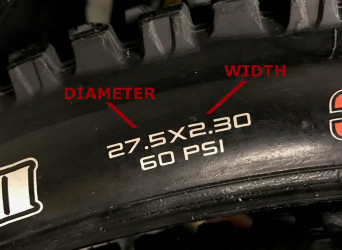Let’s face it, bike tubes can be a bit of a mystery. These unassuming rings of rubber are essential for cycling, yet picking the right one can feel like deciphering a secret code. With a myriad of sizes and valve types available, finding the perfect bike tube size for your bicycle is crucial for a smooth and safe ride.
This guide will break down everything you need to know about Bike Tube Sizes, ensuring you select the correct tube every time. We’ll cover understanding tube dimensions, valve types, and durability considerations to make you a bike tube expert.
Step 1: Decoding Bike Tube Sizes: Diameter and Width
Choosing the correct bike tube size begins with understanding two key dimensions: your wheel’s diameter and your tire’s width. These measurements are typically printed right on the sidewall of your tire, making it easy to find the information you need. Look for the format: Diameter x Width.
The first number indicates the diameter of your wheel. Common bike wheel diameters include 26″, 27.5″, 29″, and 700c, among others like 20″ and 24″ for smaller bikes. This diameter measurement needs to match your wheel size precisely.
The second number, following the “x,” represents the width of your tire, usually given in inches or millimeters. Tire widths generally range from narrow road tires around 23mm (or about 1 inch) to wider mountain bike tires exceeding 3 inches.
 Diameter x Width on a bike tube
Diameter x Width on a bike tube
Understanding bike tube dimensions. The label on a bike tube indicates the diameter and width range it is designed to fit.
While the diameter must be an exact match, the width offers more flexibility. Bike tubes are designed to stretch and accommodate a range of tire widths. For example, a tube labeled “700×23-25c” is designed to fit 700c diameter tires with widths between 23mm and 25mm. Always check the width range on the tube packaging to ensure it matches your tire width.
Sometimes, tire dimensions are listed in millimeters, such as “700x25mm”. The principle remains the same: Diameter x Width. The “c” in “700c” is a legacy from an old French sizing system and is now a standard designation for this common wheel diameter, primarily used in road and hybrid bikes.
 700c tire
700c tire
Close up of a 700c tire. 700c is a common diameter for road and hybrid bike tires, and understanding this size is crucial when selecting bike tubes.
Step 2: Selecting the Right Valve Stem Type: Schrader or Presta?
Once you’ve determined the correct bike tube size based on diameter and width, the next step is choosing the appropriate valve stem. The valve stem is the metal component that protrudes from your wheel and allows you to inflate your tires. There are two primary types of valve stems you’ll encounter: Schrader and Presta.
Schrader Valves are the more common type, often referred to as “standard” valves. They are also the same type of valve found on car tires, making them familiar and easily inflated at most gas stations with air pumps. Schrader valves are generally wider and sturdier than Presta valves.
Presta Valves, on the other hand, are typically found on higher-performance bicycles, particularly road bikes. They are narrower than Schrader valves and often feature a valve core that needs to be unlocked before inflation and locked after. Presta valves are favored in performance cycling for several reasons, including their ability to hold higher pressures and their lighter weight.
If you are unsure which valve type your bike uses, simply look at the valve stem on your current tube or wheel. If it’s wide and similar to a car tire valve, it’s likely a Schrader. If it’s thinner with a small nut at the tip, it’s probably a Presta. Your bike rim is drilled to accommodate a specific valve type, so you must choose tubes with the correct valve for your wheels.
Step 3: Considering Durability: Standard vs. Self-Sealing Bike Tubes
The final consideration when selecting bike tubes is durability and puncture protection. While standard tubes provide basic inflation, self-sealing tubes offer an added layer of defense against flats.
Standard Bike Tubes are the most common and are suitable for general riding conditions. However, they are susceptible to punctures from thorns, glass, and other road debris.
Self-Sealing Bike Tubes, like those pre-filled with Slime sealant, offer proactive flat protection. These tubes contain a sealant inside that automatically seals punctures as they occur, preventing air loss and keeping you rolling. Self-sealing tubes are ideal for riders who frequently encounter puncture hazards or want extra peace of mind.
If you already have standard tubes and want puncture protection, you can also add tire sealant separately. These sealants can be injected into your existing tubes and provide similar flat prevention benefits to self-sealing tubes.
By considering bike tube sizes (diameter and width), valve stem type (Schrader or Presta), and desired durability (standard or self-sealing), you can confidently choose the right inner tube for your bicycle. Equipped with this knowledge, you can minimize flats and maximize your enjoyment on every ride!
